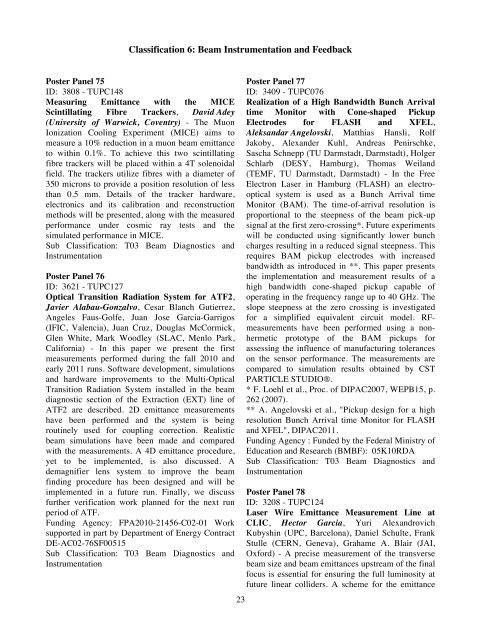Abstracts Brochure - 2nd International Particle Accelerator Conference
Abstracts Brochure - 2nd International Particle Accelerator Conference
Abstracts Brochure - 2nd International Particle Accelerator Conference
Create successful ePaper yourself
Turn your PDF publications into a flip-book with our unique Google optimized e-Paper software.
�<br />
Classification 6: Beam Instrumentation and Feedback<br />
Poster Panel 75<br />
ID: 3808 - TUPC148<br />
Measuring Emittance with the MICE<br />
Scintillating Fibre Trackers, David Adey<br />
(University of Warwick, Coventry) - The Muon<br />
Ionization Cooling Experiment (MICE) aims to<br />
measure a 10% reduction in a muon beam emittance<br />
to within 0.1%. To achieve this two scintillating<br />
fibre trackers will be placed within a 4T solenoidal<br />
field. The trackers utilize fibres with a diameter of<br />
350 microns to provide a position resolution of less<br />
than 0.5 mm. Details of the tracker hardware,<br />
electronics and its calibration and reconstruction<br />
methods will be presented, along with the measured<br />
performance under cosmic ray tests and the<br />
simulated performance in MICE.<br />
Sub Classification: T03 Beam Diagnostics and<br />
Instrumentation<br />
Poster Panel 76<br />
ID: 3621 - TUPC127<br />
Optical Transition Radiation System for ATF2,<br />
Javier Alabau-Gonzalvo, Cesar Blanch Gutierrez,<br />
Angeles Faus-Golfe, Juan Jose Garcia-Garrigos<br />
(IFIC, Valencia), Juan Cruz, Douglas McCormick,<br />
Glen White, Mark Woodley (SLAC, Menlo Park,<br />
California) - In this paper we present the first<br />
measurements performed during the fall 2010 and<br />
early 2011 runs. Software development, simulations<br />
and hardware improvements to the Multi-Optical<br />
Transition Radiation System installed in the beam<br />
diagnostic section of the Extraction (EXT) line of<br />
ATF2 are described. 2D emittance measurements<br />
have been performed and the system is being<br />
routinely used for coupling correction. Realistic<br />
beam simulations have been made and compared<br />
with the measurements. A 4D emittance procedure,<br />
yet to be implemented, is also discussed. A<br />
demagnifier lens system to improve the beam<br />
finding procedure has been designed and will be<br />
implemented in a future run. Finally, we discuss<br />
further verification work planned for the next run<br />
period of ATF.<br />
Funding Agency: FPA2010-21456-C02-01 Work<br />
supported in part by Department of Energy Contract<br />
DE-AC02-76SF00515<br />
Sub Classification: T03 Beam Diagnostics and<br />
Instrumentation<br />
23<br />
Poster Panel 77<br />
ID: 3409 - TUPC076<br />
Realization of a High Bandwidth Bunch Arrival<br />
time Monitor with Cone-shaped Pickup<br />
Electrodes for FLASH and XFEL,<br />
Aleksandar Angelovski, Matthias Hansli, Rolf<br />
Jakoby, Alexander Kuhl, Andreas Penirschke,<br />
Sascha Schnepp (TU Darmstadt, Darmstadt), Holger<br />
Schlarb (DESY, Hamburg), Thomas Weiland<br />
(TEMF, TU Darmstadt, Darmstadt) - In the Free<br />
Electron Laser in Hamburg (FLASH) an electrooptical<br />
system is used as a Bunch Arrival time<br />
Monitor (BAM). The time-of-arrival resolution is<br />
proportional to the steepness of the beam pick-up<br />
signal at the first zero-crossing*. Future experiments<br />
will be conducted using significantly lower bunch<br />
charges resulting in a reduced signal steepness. This<br />
requires BAM pickup electrodes with increased<br />
bandwidth as introduced in **. This paper presents<br />
the implementation and measurement results of a<br />
high bandwidth cone-shaped pickup capable of<br />
operating in the frequency range up to 40 GHz. The<br />
slope steepness at the zero crossing is investigated<br />
for a simplified equivalent circuit model. RFmeasurements<br />
have been performed using a nonhermetic<br />
prototype of the BAM pickups for<br />
assessing the influence of manufacturing tolerances<br />
on the sensor performance. The measurements are<br />
compared to simulation results obtained by CST<br />
PARTICLE STUDIO®.<br />
* F. Loehl et al., Proc. of DIPAC2007, WEPB15, p.<br />
262 (2007).<br />
** A. Angelovski et al., "Pickup design for a high<br />
resolution Bunch Arrival time Monitor for FLASH<br />
and XFEL", DIPAC2011.<br />
Funding Agency : Funded by the Federal Ministry of<br />
Education and Research (BMBF): 05K10RDA<br />
Sub Classification: T03 Beam Diagnostics and<br />
Instrumentation<br />
Poster Panel 78<br />
ID: 3208 - TUPC124<br />
Laser Wire Emittance Measurement Line at<br />
CLIC, Hector Garcia, Yuri Alexandrovich<br />
Kubyshin (UPC, Barcelona), Daniel Schulte, Frank<br />
Stulle (CERN, Geneva), Grahame A. Blair (JAI,<br />
Oxford) - A precise measurement of the transverse<br />
beam size and beam emittances upstream of the final<br />
focus is essential for ensuring the full luminosity at<br />
future linear colliders. A scheme for the emittance


